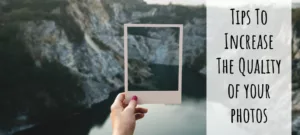What do you think takes to be a good photographer? A good camera? Some good accessories? Or a good lens? Well, let us tell you a little secret. Neither of the things we just mentioned will help you in becoming a good photographer. It is ultimately you, not your camera which will click good pictures. There are some good photographers and then there are great ones. In order to become a great photographer not only will you require clicking images, rather you will also require editing them intelligently for the world to see and appreciate.
Today we mention Top 7 tips which will help you increase the quality of images which you click.
1. Don’t Skip the Post Processing Part
After clicking an image, the best way to achieve great quality photos is to post edit them. It is entirely your call how you will edit any picture and what photo enhancer tools will you use. But don’t skip this part. Every image in order to transform from good to great will require post-processing which can be setting its tone, its contrast or changing the colors all together.
2. Always Store RAW image files
With photography gadgets being evolved continuously there are DSLR’s which in order to save storage space compress the photo you click. Most cameras will have the image stored in a JPEG format which is normally a compressed version. In case you wish to improve quality of your photos try having the RAW image stored on your memory card as this gives you more data which you can edit. Almost all the cameras today come with a feature of storing RAW photos which you can later edit according to your needs.
3. Go Easy with Editing
It doesn’t matter what sort of feature in your image you try to edit. It can be the contrast of the image or its saturation, however, make sure you don’t do too much of it. People tend to spoil photos by over-editing it. If you are new to photography here are a few tips which beginners can use while editing their photos.
4. Learn the Rule of Thirds
One of the best ways to click and compose a stronger photograph is to follow the rule of thirds. According to the rule of thirds, you should divide any image into vertical and horizontal thirds. The point at which these thirds meet is where you are required to place your subject. This technique is a powerful tool for beginners to improve their photography, it might not work in all scenarios, however, does work in most of them.
5. Keep in Mind the Compression Effects
While clicking a photograph you may not pay much heed to objects in your background provided you have a depth perception. To explain, consider yourself clicking an image of a woman standing in front of a lamp post. While you may not pay attention to the lamp post behind as you can see it in 3D, when you click the image and view it in 2D you may see the lamp post growing out of woman’s head. Cameras do not have a depth perception as they render the image in 2D. Make sure of the background you choose keeping in mind the compression effects. If you find the background looks strange to choose a different position or shot to exclude it.
6. Learn How to Use Lights
People often say that their images couldn’t be good because the light was bad. The thing is there is no such situation as a bad light. In fact, it is you photographers who need to learn the art of choosing the right light. For example, if you wish to click an image of a glowing landscape, the bright sunlight during the afternoon is the best time for same. However, this midday light isn’t so great should you want to conduct a portrait shoot. Choose the lights or time according to the type of photo you wish to click. Once you master this art you yourself would agree with us on the fact that there is no such thing as ‘bad light’.
7. Try to Leave Out Flash
Using flash can be a tempting choice for you to make in situations of poor light. However, a flash isn’t a good thing to use until the time you have an alternate source from where you can bounce back the flashlight for a softer touch. Images clicked under flash generally don’t turn up to be good ones.
So, these 7 tips we think might be helpful enough to transform the quality of images you click. Should you have any other suggestions to give, feel free to mention them in the comment section below.








